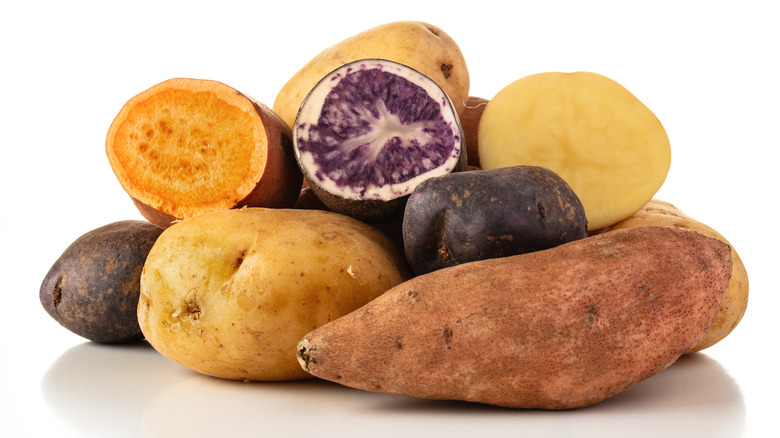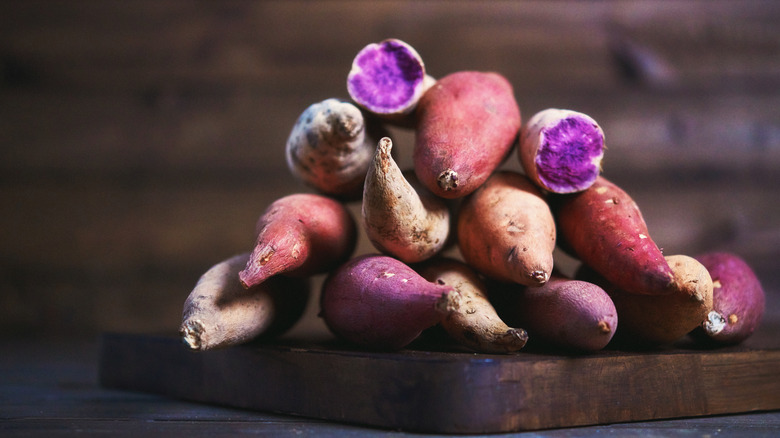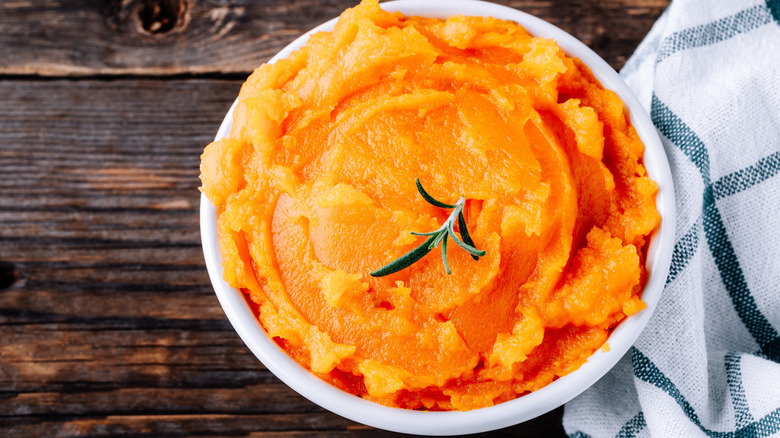For The Best Sweet Potato Cake, Know Which Varieties To Avoid
While some dessert lovers could swoon over that slice of cake being a serving of vegetables, the Southern classic sweet potato cake is more of a treat. Although the root vegetable can be served in many ways, when used as a baking ingredient, it is best to be selective. For the perfect cake crumb, some varieties are better than others.
Although the term moist can make some people cringe, moisture is key to a great sweet potato cake, and picking the better sweet potato is key. Grocery stores tend to sell orange or red-skinned varieties mostly. Cultivated for mass production, the common potato variety is categorized as "soft." According to the Seattle Times, that soft description refers to how the potato retains moisture during cooking, resulting in a creamy consistency. It is one of the reasons why these types of potatoes are preferred for a sweet potato cake.
Purple sweet potatoes or lighter, almost white, varieties should be avoided for baking. Those varieties' texture is too dense when incorporated into a batter. That firmness would need to be offset with additional liquid, which could create an ingredient imbalance.
Given that baking is a science, it might be best to stick with what farmers have learned from the potato crops. Soft sweet potatoes are the better choice to put that cake recipe on track to be a slice to remember.
Best sweet potatoes varieties for baking recipes
Whether served as a picture-perfect bundt cake or carefully decorated with cream cheese frosting, the sweet potato cake offers a bite of warm, comforting flavor. Although grandma's recipe might have perfected the spice blend, using the right sweet potato variety is vital to ensuring a delectable slice arrives on the plate.
According to Gardner's Path, sweet potatoes, not yams, can be found in over 20 varieties. While some of the differences might be subtle, each root vegetable is slightly different and can produce different results for dishes. From texture to sugar levels, choosing the better one is more than just shoving a spud in the produce bag.
The Beauregard variety is the most common option found in grocery stores. In addition to its high moisture content, the sweet, mashable texture is perfect for baking. From cakes to pies, it is a popular choice. Another popular option due to its high yield for farmers is Centennial. Similar to the Beauregard, this potato is a sweet, moist, mashable option. The vibrant orange hue adds visual appeal to a dessert.
The biggest takeaway when incorporating sweet potatoes into a dessert recipe is to be thoughtful. Just like red potatoes do not make the best French fries, not all sweet potatoes are best for baking.
Can you use canned sweet potatoes?
Since baking is a science, using the best ingredients can help to create the most scrumptious bite. While careful measurements are a must, sometimes, the perceived simple swap might not be the best choice. Although canned sweet potatoes might skip a step, that scoop of puree can impact the final flavor.
Anyone who has mistakenly put spiced canned pumpkin puree in that pumpkin ravioli can appreciate that carefully reading a label matters. With canned sweet potatoes in a cake or other baked recipe, it is best to use ingredients that have not been seasoned, i.e., no added nutmeg, cinnamon, etc. While warm spices in that cake can be delightful, too much of an ingredient can lead to imbalance. Canned sweet potatoes should be just pureed potatoes, no extras needed.
If seasoned canned sweet potatoes are the only option, it is best to do a taste test before adding the ingredient to the recipe. Other ratios might need to be tweaked. From cutting back on the sugar to adding a touch more allspice, changes can bring the flavor back to its original intent. Canned ingredients can be a baking hack as long as the final result is a tasty one.


